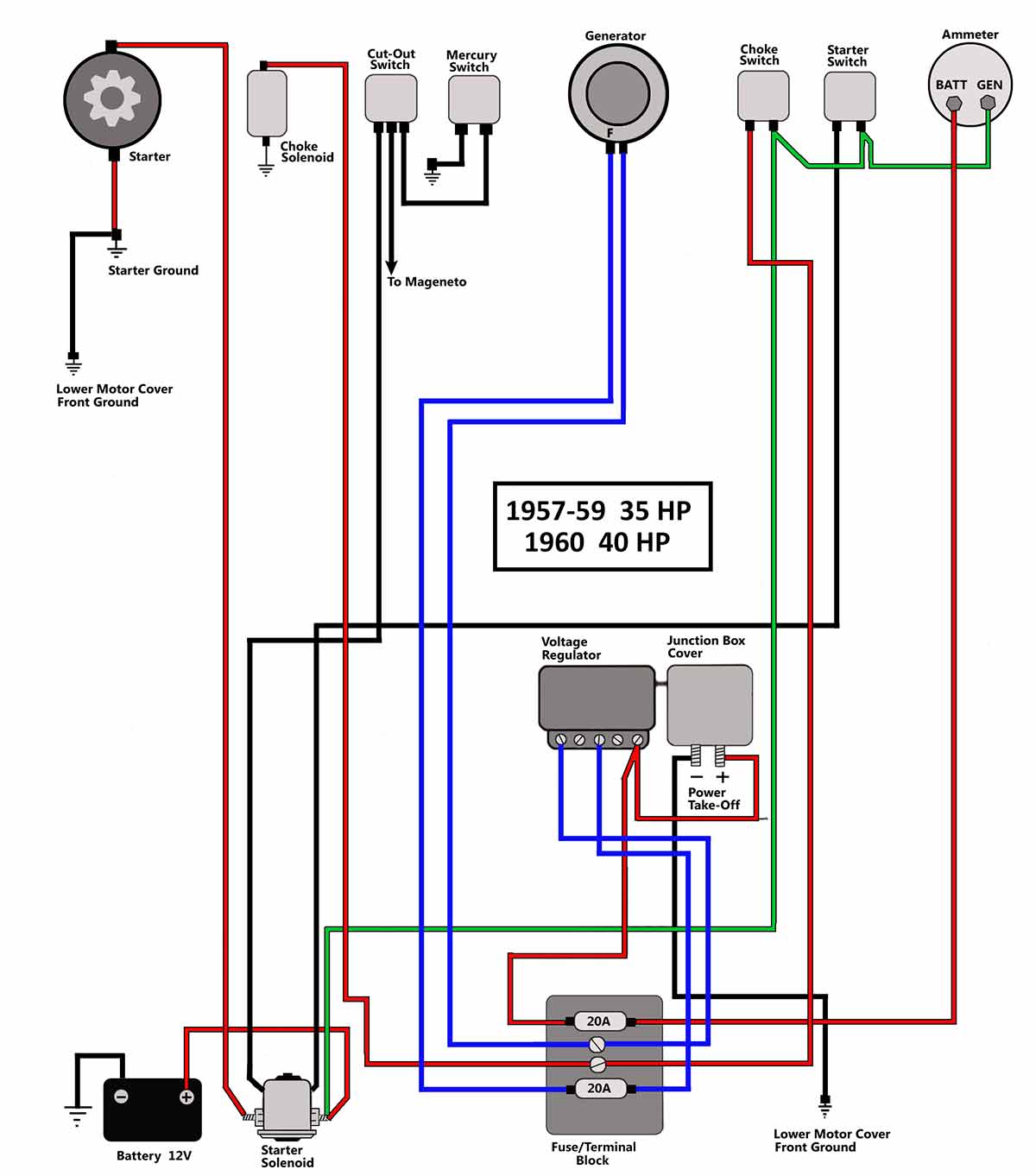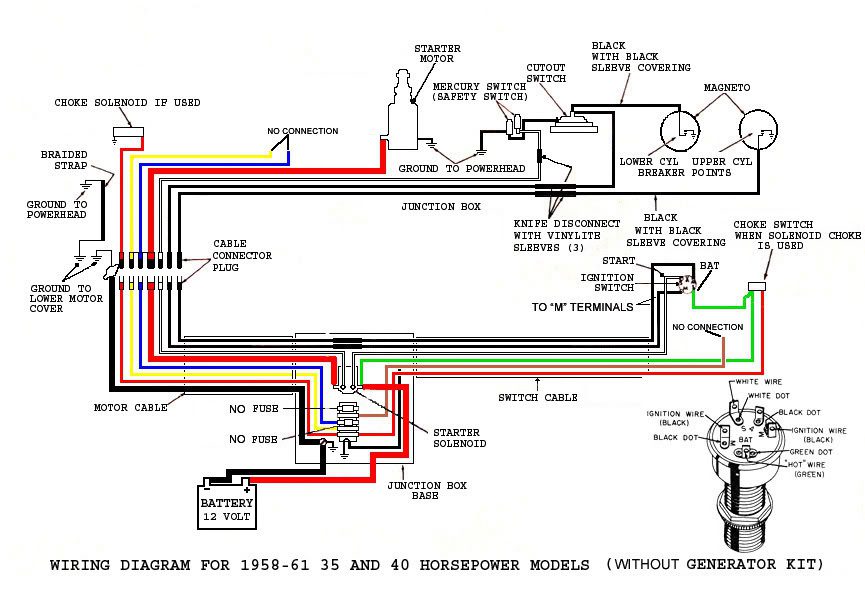Home › Forum › Ask A Member › Johnson RDSL-21 mercury Switches
- This topic has 42 replies, 9 voices, and was last updated 3 years, 2 months ago by
Tom Alexander.
-
AuthorPosts
-
February 7, 2022 at 10:38 pm #254246
I somehow ended up with a Thompson 14′ Sea Skiff last year with the original 1959 Johnson RDSL-21 35HP engine. Boat is all restored now. Some time ago I started on a re-do of the engine. The gearbox was frozen so I sorted it out and had a look around the power head etc. I noticed that the lead to the aft mercury switch case (ground for both the switches) was fried beyond a simple repair so I bought a new set of switches as they come as a pair. I installed them and thought “well that is what is keeping this from running’. The powerhead has turned over, had spark and about 95 psi of compression so I was hopeful. Well today was the day it was mounted on the boat and it came time to start it up. First turn of the key to ‘start’ I noticed a puff of smoke from the area that these mercury switches are mounted. Stopped immediately and yep, the lead from the ground had se soldered itself. I was able to re-solder it this time. I took the switches out of the circuit and lo and behold the engine started. Only ran it for a minute or so and at ‘idle’. So a couple of questions. I understand that the forward switch is part of the ‘cut-out circuit’, and the after switch is to prevent over reving the engine in neutral. Schematics I have seen show one switch (presumably the forward switch) in series with the start solenoid. But with the switch disconnected the solenoid still pulls in and the motor starts. Anybody out there know about these mercury switches and why I might be frying the ground connection? Also now that the engine started and ran a minute or two, is cooling water supposed to flow from the small hole above the waterline or just sort of spray from the larger hole that has a short corrugated hose leading into it? I have the engine immersed in water to above the water pick up and that pick up has a plate modified to take a hose which I have fastened to it and water flow/pressure into it. Thanks, Hope someone has a bit of input for me. It’s great to get the engine running again (first start since 1965!) But as always, these things lead to more questions. Thanks Tom Alexander
February 8, 2022 at 3:15 am #254255You are using an automotive starter solenoid, aren’t you? That’ll fry the mercury switch in a heartbeat. As you have figured out, it is in series with the solenoid coil to prevent the starter from running (starting) at high throttle settings. However, the car solenoid is different inside. On a car solenoid, the second small terminal is not in series. What it does in this case is shoot a full 12V whallop to bypass the car’s ignition resistor for a hotter spark while cranking. Put it on a n OMC outboard and that full 12V whallop goes to the mercury switch and zap!
I think you are asking about the drain hole for the drive shaft isolation tube. Yes, water will run out of that hole. Water will spray out of the exhaust relief hole in differing rates, depending on thermostat state.
-
This reply was modified 3 years, 2 months ago by
 frankr.
frankr.
February 8, 2022 at 1:32 pm #254270This photo shows the internal wiring of an OMC outboard starter solenoid. You can see the two tiny wires coming from the small terminals on the solenoid and they go into the magnet coils windings, which is encased in epoxy here. The magnet coil is hooked in series and acts as a resistor, preventing full battery power from reaching the mercury switches.
A four terminal Ford style solenoid looks similar from the outside but is wired differently inside. As Frank stated, it will allow full battery power to reach the mercury switches, which isn’t good.
February 8, 2022 at 2:22 pm #254283Hi Guys. Frank and Mumbles. I don’t see my replies to you guys but please accept my thanks for you help!! I have ordered new mercury switches as well as a new solenoid per your information. I hope there is a time where I can help other folks in the way you guys helped me solve this issue. I am going to the yard now to run the engine at relatively low speed to get enough time on it to see in thermostat allows more water to come out water outlet that happened in first couple of minutes yesterday. I have temporarily removed the mercury switched from the system and will be sure to not do what they were in the system to prevent. I have the engine in a cut down 55 gallon plastic drum immersed to about 8 inches above the water pick ups and have one of this plates with a hose adapter screwed to the water pick up port on the port side. We’ll see. Again, Thanks for this info!!!!! Tom Alexander
February 8, 2022 at 2:46 pm #254284About that thermostat. In all probability, it will not open at all at idle speeds, especially in cold lake water. Under such conditions, the water returns to the water pump for recycling till it gets warm enough to open the thermostat. However, there will be a bit of water bypassing the thermostat even when closed in order to cool the exhaust. That bypass water should show up as a light spray out the exhaust relief port, and when the ‘stat opens the spray will be heavier. Important thing to remember is the ‘stat is constantly sampling the water temperature and opens and/or closes as needed to try to maintain ideal powerhead temperature. In other words, the discharge spray also comes and goes according to thermostat state.
February 8, 2022 at 3:22 pm #254285Here’s a ’59 Big Twin which should be the same under the hood as your RDSL. This motor had just been rebuilt and I was carefully watching the water flow coming out of the back. It wasn’t gushing out as I expected but then again the motor wasn’t under load and wouldn’t have been generating much heat to open the thermostat much. It was cold and wet the day I filmed it and I’m sure that’s why there was so much steam.
Just noticed that was nine years ago when I had it running! Where does the time go? When it warms up a bit I should wheel it out of the garage and fire it up again to see if it still steams as much.
-
This reply was modified 3 years, 2 months ago by
 Mumbles.
Mumbles.
February 8, 2022 at 10:57 pm #254300Hi Frank & Mumbles:Thanks again for all the info. Today I ran the engine again several times. I have cut down a plastic 55 gal. drum and have the motor on the back of the boat hanging into the water. After looking at your u-tube vid with the cooling water, today I was focused on cooling. I never ran the engine at any time for more than 3 or so minutes with at least 45 minutes before starting it again. I ran it first time with the hose from municipal water supply coupled into the plate I bought to allow pressurized water into the side water intake with the engines lower part still immersed . With this arrangement I did get s ’spray’ of water coming out the port below the cowling on the rear off the engine. After shutting down I removed the plate and the next test run was done with the lower unit submerged so water level was a couple of inches above that side water inlet port. When the engine was running this way I saw only steam(?) coming from the water outlet port. Note that I wasn’t running the engine long enough (in my opinion) for the thermostat to do anything but circulate water inside the engine, but there was a noticeable difference between forcing water into the port and having the water pump suck water from the drum. When I ran the engine the first time this AM I got a lot of oily scum on top of the water in the drum. I put an oil absorbent diaper on top of the water and it sucked up 95% of it. But still it was amazing to see what was coming out of the exhaust! I should mention that there is a new water pump body and impeller in the engine as well as all the other new seals bearing and whatnot I put in when rebuilding the gear case. I have a test wheel on the shaft and it makes quite a froth of the water in the drum and I wonder how effectively the pump can pull this air water mix up. Just wondering. Now I have to learn how to post video onto u-tube.Your use of u-tube is impressive. Talk about a picture being worth a thousand words! In my job (now retired) we used a corporate platform and had IT folks to help. I should be able to get the hang of it now I have a need. I will copy this and put it as a reply on the thread in the AOMCI site so it should get thru one way or another. BTW the drawings of the elect system are spot on as to what is in the boat/motor combo. Once I get the proper solenoid I can reinstate the mercury switches and be back to ‘as manufactured’! Thanks Tom Alexander
February 9, 2022 at 4:56 am #254302https://maxrules.com/JOwireindex.php
for your next oldy 🙂
Joining AOMCI has priviledges 🙂
1 user thanked author for this post.
February 9, 2022 at 12:28 pm #254323Crosbyman: Thanks for the link! I wish they had the full powerhead rebuild kit for the 1959 35hp RDSL-21. Some of the other things they do have will prove useful over the next year I am sure. Thanks Again Tom Alexander
February 9, 2022 at 2:17 pm #254326we talking gaskets kits here ?? or internal parts
did you get yourself a copy of the red book downloaded from Garry Spencer’S drop box in the Library under Inner sanctum under MEMBERS ONLY tab ?
JEK018 – Johnson/Evinrude Gasket Kit 35 hp 2 cyl / 1958-59 (head gaske – VintageOutboard.com
Joining AOMCI has priviledges 🙂
-
This reply was modified 3 years, 2 months ago by
crosbyman.
-
This reply was modified 3 years, 2 months ago by
-
AuthorPosts
- You must be logged in to reply to this topic.




